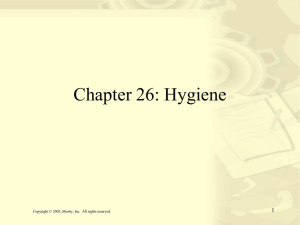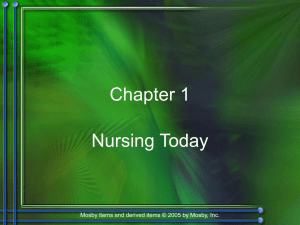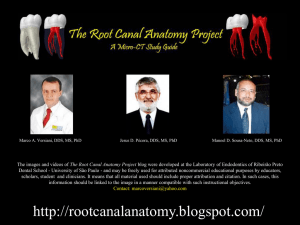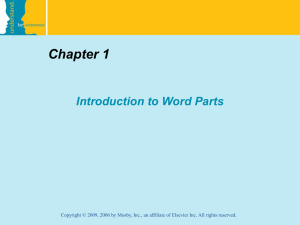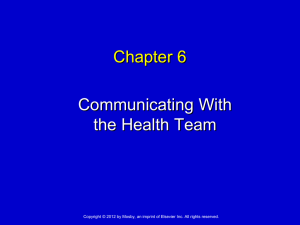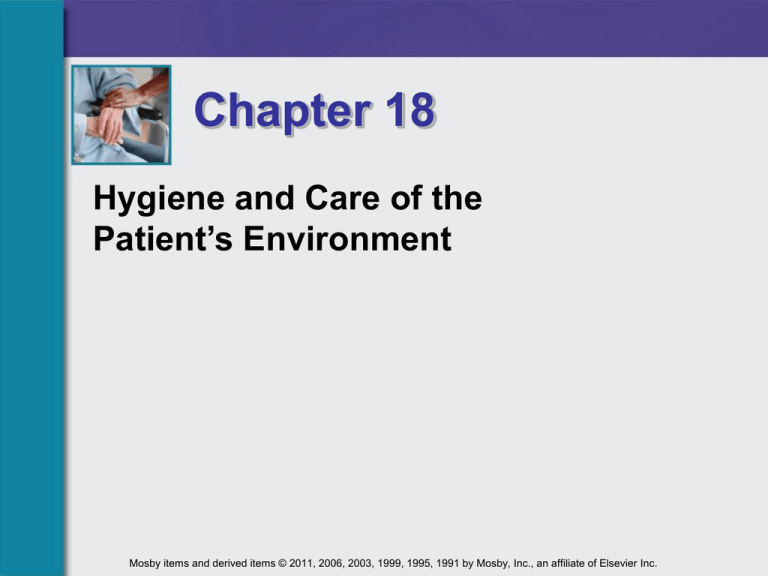
Chapter 18
Hygiene and Care of the
Patient’s Environment
Mosby items and derived items © 2011, 2006, 2003, 1999, 1995, 1991 by Mosby, Inc., an affiliate of Elsevier Inc.
Hygiene and Care of the Patient’s
Environment
• Personal Hygiene
The self-care measures persons use to maintain their
health
• Hygiene
The science of health
Includes care of the skin, hair, hands, feet, eyes, ears,
nose, mouth, back, and perineum
• Conscientious personal hygienic practices are
essential for the nurse; nurses are role models.
Mosby items and derived items © 2011, 2006, 2003, 1999, 1995, 1991 by Mosby, Inc., an affiliate of Elsevier Inc.
Slide 2
Hygiene and Care of the Patient’s
Environment
• Factors Influencing Personal Hygiene
Social practices
Body image
Socioeconomic status
Knowledge
Personal preference
Physical condition
Cultural variables
Mosby items and derived items © 2011, 2006, 2003, 1999, 1995, 1991 by Mosby, Inc., an affiliate of Elsevier Inc.
Slide 3
Patient’s Room Environment
• Maintaining Comfort
Room temperature: 68° to 74° F
Good ventilation
Bedpans and urinals that are emptied and rinsed
promptly
Monitored noise level
Proper lighting
Mosby items and derived items © 2011, 2006, 2003, 1999, 1995, 1991 by Mosby, Inc., an affiliate of Elsevier Inc.
Slide 4
Figure 18-1
(From Potter, P.A., Perry, A.G. [2005]. Fundamentals of nursing. [6th ed.]. St. Louis: Mosby.)
A typical hospital room.
Mosby items and derived items © 2011, 2006, 2003, 1999, 1995, 1991 by Mosby, Inc., an affiliate of Elsevier Inc.
Slide 5
Patient’s Room Environment
• Room Equipment
Bedside stand
• Used to store the patient’s personal articles and
hygienic equipment
Overbed table
• On wheels; is adjustable to various heights over the bed
or a chair
Chairs
• Straight chairs and lounge chairs
Mosby items and derived items © 2011, 2006, 2003, 1999, 1995, 1991 by Mosby, Inc., an affiliate of Elsevier Inc.
Slide 6
Patient’s Room Environment
• Room Equipment (continued)
Lights
• Lights provide comfort, safety, and ease.
• Call light signal indicates that a patient needs
assistance.
Bed
• Bed is designed for comfort, safety, and adaptability to
position changes.
• It has a number of safety features.
Mosby items and derived items © 2011, 2006, 2003, 1999, 1995, 1991 by Mosby, Inc., an affiliate of Elsevier Inc.
Slide 7
Bathing
• Sitz Bath
Cleanses and aids in reducing inflammation of the
perineal and anal areas of the patient who has
undergone rectal or vaginal surgery or childbirth
Water temperature 98° to 102° F
• Cool Water Tub Bath
May be given to relieve tension or lower body
temperature
Water temperature tepid, not cold—98.6° F
Mosby items and derived items © 2011, 2006, 2003, 1999, 1995, 1991 by Mosby, Inc., an affiliate of Elsevier Inc.
Slide 8
Figure 18-2
(From Potter, P.A., Perry, A.G. [2005]. Fundamentals of nursing. [6th ed.]. St. Louis: Mosby.)
The sitz bath.
Mosby items and derived items © 2011, 2006, 2003, 1999, 1995, 1991 by Mosby, Inc., an affiliate of Elsevier Inc.
Slide 9
Bathing
• Warm Water Tub Bath
Given to reduce muscle tension
Water temperature 109.4° F
Observe s/s of dizziness/fainting
• Hot Water Tub Bath
Given to assist in relieving muscle soreness and
muscle spasms
Water temperature 113° to 115° F
Mosby items and derived items © 2011, 2006, 2003, 1999, 1995, 1991 by Mosby, Inc., an affiliate of Elsevier Inc.
Slide 10
Mosby items and derived items © 2011, 2006, 2003, 1999, 1995, 1991 by Mosby, Inc., an affiliate of Elsevier Inc.
Slide 11
Bathing
• Other Baths
Complete bed bath
• For patients who are totally dependent and require total
assistance
Tepid sponge bath
• Administered to reduce an elevated temperature
Medicated bath
• May include agents such as oatmeal, cornstarch,
Burow’s solution, and soda bicarbonate
• To reduce tension and relax the patient and to relieve
pruritus caused by certain skin disorders
Mosby items and derived items © 2011, 2006, 2003, 1999, 1995, 1991 by Mosby, Inc., an affiliate of Elsevier Inc.
Slide 12
Skill 18-1: Steps 8h & 8i
(From Potter, P.A., Perry, A.G. [2005]. Fundamentals of nursing. [6th ed.]. St. Louis: Mosby.)
Bed bath.
Mosby items and derived items © 2011, 2006, 2003, 1999, 1995, 1991 by Mosby, Inc., an affiliate of Elsevier Inc.
Slide 13
Skill 18-1: Steps 8r & 8u
(From Potter, P.A., Perry, A.G. [2005]. Fundamentals of nursing. [6th ed.]. St. Louis: Mosby.)
Bed bath.
Mosby items and derived items © 2011, 2006, 2003, 1999, 1995, 1991 by Mosby, Inc., an affiliate of Elsevier Inc.
Slide 14
Skill 18-1: Steps 10d(1) & 10d(4)
Towel bath.
Mosby items and derived items © 2011, 2006, 2003, 1999, 1995, 1991 by Mosby, Inc., an affiliate of Elsevier Inc.
Slide 15
Skill 18-1: Step 10e2
(From Elkin, M.K., Perry, A.G., Potter, P.A. [2004]. Nursing interventions and clinical skills. [3rd ed.].
St. Louis: Mosby.)
Towel bath.
Mosby items and derived items © 2011, 2006, 2003, 1999, 1995, 1991 by Mosby, Inc., an affiliate of Elsevier Inc.
Slide 16
Bathing
• Back Care/Back Rub
Usually administered after the patient’s bath
Promotes relaxation, relieves muscular tension, and
stimulates circulation
Nurse massages for 3 to 5 minutes
Contraindicated if the patient has such conditions as
fractures of the ribs or vertebral column, burns,
pulmonary embolism, or open wounds
Mosby items and derived items © 2011, 2006, 2003, 1999, 1995, 1991 by Mosby, Inc., an affiliate of Elsevier Inc.
Slide 17
Skill 18-1: Steps 14e & 14f
(From Potter, P.A., Perry, A.G. [2005]. Fundamentals of nursing. [6th ed.]. St. Louis: Mosby.)
Back rub.
Mosby items and derived items © 2011, 2006, 2003, 1999, 1995, 1991 by Mosby, Inc., an affiliate of Elsevier Inc.
Slide 18
Components of the Patient’s
Hygiene
• Care of the Skin
When a person’s physical condition changes, the skin
often reflects this through alterations in color,
thickness, texture, turgor, temperature, and hydration.
As long as the skin remains intact and healthy, its
physiological function remains optimal.
Mosby items and derived items © 2011, 2006, 2003, 1999, 1995, 1991 by Mosby, Inc., an affiliate of Elsevier Inc.
Slide 19
Mosby items and derived items © 2011, 2006, 2003, 1999, 1995, 1991 by Mosby, Inc., an affiliate of Elsevier Inc.
Slide 20
Components of the Patient’s
Hygiene
• Care of the Skin (continued)
Collection of data
• Normal skin has the following characteristics:
Intact without abrasions
Warm and moist
Localized changes in texture across surface
Good turgor; generally smooth and soft
Skin color variations from body part to body part
Mosby items and derived items © 2011, 2006, 2003, 1999, 1995, 1991 by Mosby, Inc., an affiliate of Elsevier Inc.
Slide 21
Components of the Patient’s
Hygiene
• Care of the Skin (continued)
Impaired skin integrity
• A patient who stays in one position without relief of
pressure can develop a pressure sore.
• Patients especially at risk are the chronically ill,
debilitated, older, disabled, or incontinent patient and
the patient with spinal cord injuries, limited mobility, or
poor overall nutrition.
Mosby items and derived items © 2011, 2006, 2003, 1999, 1995, 1991 by Mosby, Inc., an affiliate of Elsevier Inc.
Slide 22
Pressure sore staging
Mosby items and derived items © 2011, 2006, 2003, 1999, 1995, 1991 by Mosby, Inc., an affiliate of Elsevier Inc.
Slide 23
Figure 18-5
(From Potter, P.A., Perry, A.G. [2005]. Fundamentals of nursing. [6th ed.]. St. Louis: Mosby.)
Thirty-degree lateral position to avoid pressure points.
Mosby items and derived items © 2011, 2006, 2003, 1999, 1995, 1991 by Mosby, Inc., an affiliate of Elsevier Inc.
Slide 24
Figure 18-6
Using a rolled bath blanket as a pressure-reducing device.
Mosby items and derived items © 2011, 2006, 2003, 1999, 1995, 1991 by Mosby, Inc., an affiliate of Elsevier Inc.
Slide 25
Components of the Patient’s
Hygiene
• Care of the Skin (continued)
Impaired skin integrity
• Pressure ulcers occur when there is sufficient pressure
on the skin to cause the blood vessels in an area to
collapse.
• The flow of blood and fluid to the cells is impaired,
resulting in ischemia to the cells.
• When the external pressure against the skin is greater
than the pressure in the capillary bed, blood flow
decreases to the adjacent tissue.
• If the pressure continues for longer than 2 hours, cell
necrosis may occur.
Mosby items and derived items © 2011, 2006, 2003, 1999, 1995, 1991 by Mosby, Inc., an affiliate of Elsevier Inc.
Slide 26
Mosby items and derived items © 2011, 2006, 2003, 1999, 1995, 1991 by Mosby, Inc., an affiliate of Elsevier Inc.
Slide 27
Components of the Patient’s
Hygiene
• Care of the Skin (continued)
Impaired skin integrity
• Shearing force
The tissue layers of skin slide onto each other, resulting
in kinking or stretching of subcutaneous blood vessels;
this results in an interruption of blood flow to the skin.
• Friction
Rubbing of skin over a surface produces friction, which
may remove layers of tissue.
Mosby items and derived items © 2011, 2006, 2003, 1999, 1995, 1991 by Mosby, Inc., an affiliate of Elsevier Inc.
Slide 28
Mosby items and derived items © 2011, 2006, 2003, 1999, 1995, 1991 by Mosby, Inc., an affiliate of Elsevier Inc.
Slide 29
Figure 18-3
(From Potter, P.A., Perry, A.G. [2005]. Fundamentals of nursing. [6th ed.]. St. Louis: Mosby.)
Diagram of shearing force exerted against sacral area.
Mosby items and derived items © 2011, 2006, 2003, 1999, 1995, 1991 by Mosby, Inc., an affiliate of Elsevier Inc.
Slide 30
Components of the Patient’s
Hygiene
• Care of the Skin (continued)
Stages of pressure ulcers
• Stage I: nonblanchable erythema of the skin
• Stage II: partial-thickness skin loss; epidermis
• Stage III: full-thickness skin loss, damage or
necrosis of subcutaneous tissue
• Stage IV: full-thickness skin loss with
extensive destruction, tissue necrosis,
or damage to muscle, bone, or
supporting structures
Mosby items and derived items © 2011, 2006, 2003, 1999, 1995, 1991 by Mosby, Inc., an affiliate of Elsevier Inc.
Slide 31
Figure 18-4, A
(From Potter, P.A., Perry, A.G. [2005]. Fundamentals of nursing. [6th ed.]. St. Louis: Mosby.)
A, Stage I pressure ulcer.
Mosby items and derived items © 2011, 2006, 2003, 1999, 1995, 1991 by Mosby, Inc., an affiliate of Elsevier Inc.
Slide 32
Figure 18-4, B
(From Potter, P.A., Perry, A.G. [2005]. Fundamentals of nursing. [6th ed.]. St. Louis: Mosby.)
B, Stage II pressure ulcer.
Mosby items and derived items © 2011, 2006, 2003, 1999, 1995, 1991 by Mosby, Inc., an affiliate of Elsevier Inc.
Slide 33
Figure 18-4, C
(From Potter, P.A., Perry, A.G. [2005]. Fundamentals of nursing. [6th ed.]. St. Louis: Mosby.)
C, Stage III pressure ulcer .
Mosby items and derived items © 2011, 2006, 2003, 1999, 1995, 1991 by Mosby, Inc., an affiliate of Elsevier Inc.
Slide 34
Figure 18-4, D
(From Potter, P.A., Perry, A.G. [2005]. Fundamentals of nursing. [6th ed.]. St. Louis: Mosby.)
D, Stage IV pressure ulcer .
Mosby items and derived items © 2011, 2006, 2003, 1999, 1995, 1991 by Mosby, Inc., an affiliate of Elsevier Inc.
Slide 35
Stable eschar of heelS
Mosby items and derived items © 2011, 2006, 2003, 1999, 1995, 1991 by Mosby, Inc., an affiliate of Elsevier Inc.
Slide 36
Components of the Patient’s
Hygiene
• Care of the Skin (continued)
Nursing interventions
• Assess improvement.
• Assess size and depth of the ulcer, the amount and
color of any exudate, the presence of pain or odor, and
the color of the exposed tissue.
• Specific interventions are determined by the stage of
the ulcer.
Mosby items and derived items © 2011, 2006, 2003, 1999, 1995, 1991 by Mosby, Inc., an affiliate of Elsevier Inc.
Slide 37
Components of the Patient’s
Hygiene
• Oral Hygiene
Care of the oral cavity
Helps maintain a healthy state of the mouth, teeth,
gums, and lips
Brushing the teeth removes food particles, plaque,
and bacteria; massages the gums; and relieves
discomfort resulting from unpleasant odors and tastes.
Mosby items and derived items © 2011, 2006, 2003, 1999, 1995, 1991 by Mosby, Inc., an affiliate of Elsevier Inc.
Slide 38
Skill 18-2: Steps 9a & 9c
(From Elkin, M.K., Perry, A.G., Potter, P.A. [2004]. Nursing interventions and clinical skills. [3rd ed.].
St. Louis: Mosby.)
(From Potter, P.A., Perry, A.G. [2005]. Fundamentals of nursing. [6th ed.]. St. Louis: Mosby.)
Administering oral hygiene.
Mosby items and derived items © 2011, 2006, 2003, 1999, 1995, 1991 by Mosby, Inc., an affiliate of Elsevier Inc.
Slide 39
Components of the Patient’s
Hygiene
• Oral Hygiene (continued)
Dentures
• A set of artificial teeth not permanently fixed.
• Should be stored in an enclosed, labeled cup for
soaking or when they are not worn
• Should be cleaned as often as for natural teeth to
prevent infection and irritation
• Oral care provided on a regular basis
Mosby items and derived items © 2011, 2006, 2003, 1999, 1995, 1991 by Mosby, Inc., an affiliate of Elsevier Inc.
Slide 40
Skill 18-2: Step 10c
(From Potter, P.A., Perry, A.G. [2005]. Fundamentals of nursing. [6th ed.]. St. Louis: Mosby.)
Administering oral hygiene.
Mosby items and derived items © 2011, 2006, 2003, 1999, 1995, 1991 by Mosby, Inc., an affiliate of Elsevier Inc.
Slide 41
Components of the Patient’s
Hygiene
• Hair Care
Combing, brushing, and shampooing are basic
hygiene measures for all patients.
Patient may shampoo in the shower or tub, use a
portable chair in front of a sink, or in bed.
• Shaving the Patient
Patient may prefer to shave at the time of bathing.
Patients who have a bleeding disorder or are taking
anticoagulants should use electric razors.
Do not allow a disoriented or depressed patient to use
a razor with a blade.
Mosby items and derived items © 2011, 2006, 2003, 1999, 1995, 1991 by Mosby, Inc., an affiliate of Elsevier Inc.
Slide 42
Skill 18-3: Steps 9a & 10e
(From Potter, P.A., Perry, A.G. [2005]. Fundamentals of nursing. [6th ed.]. St. Louis: Mosby.)
(From Elkin, M.K., Perry, A.G., Potter, P.A. [2004]. Nursing interventions and clinical skills. [3rd ed.].
St. Louis: Mosby.)
Care of the hair, nails, and feet.
Mosby items and derived items © 2011, 2006, 2003, 1999, 1995, 1991 by Mosby, Inc., an affiliate of Elsevier Inc.
Slide 43
Components of the Patient’s
Hygiene
• Hand, Foot, and Nail Care
Hands and feet often require special attention to
prevent infection, odors, and injury.
Assessment
• Examine all skin surfaces.
• Carefully assess between the toes.
• Observe for adequate circulation.
Mosby items and derived items © 2011, 2006, 2003, 1999, 1995, 1991 by Mosby, Inc., an affiliate of Elsevier Inc.
Slide 44
Components of the Patient’s
Hygiene
• Eye, Ear, and Nose Care (continued)
Care of the eyes
• Cleansing of the circumorbital area of the eyes is
usually performed during the bath.
• Case involves washing with a clean washcloth
moistened with clear water.
• The use of soap is omitted because it may cause
burning and irritation.
• The eye is cleansed from the inner to the outer canthus.
• Patient may need assistance with care of eyeglasses or
contact lenses.
Mosby items and derived items © 2011, 2006, 2003, 1999, 1995, 1991 by Mosby, Inc., an affiliate of Elsevier Inc.
Slide 45
Mosby items and derived items © 2011, 2006, 2003, 1999, 1995, 1991 by Mosby, Inc., an affiliate of Elsevier Inc.
Slide 46
Components of the Patient’s
Hygiene
• Eye, Ear, and Nose Care (continued)
Care of the ears
• The ears are cleansed by the nurse during the bed
bath.
• A clean corner of a moistened washcloth rotated gently
into the ear canal works best for cleaning.
• A cotton-tipped applicator is useful for cleansing the
pinna.
• The nurse should teach patients never to use bobby
pins, toothpicks, or cotton-tipped applicators to clean
the internal auditory canal.
Mosby items and derived items © 2011, 2006, 2003, 1999, 1995, 1991 by Mosby, Inc., an affiliate of Elsevier Inc.
Slide 47
Components of the Patient’s
Hygiene
• Eye, Ear, and Nose Care (continued)
Care of the ears (continued)
• Hearing aids
This involves routine cleaning, battery care, and proper
insertion technique.
When not in use, the hearing aid should be stored where
it will not become damaged.
Mosby items and derived items © 2011, 2006, 2003, 1999, 1995, 1991 by Mosby, Inc., an affiliate of Elsevier Inc.
Slide 48
Figure 18-8
(From Elkin, M.K., Perry, A.G., Potter, P.A. [2004]. Nursing interventions and clinical skills. [3rd ed.].
St. Louis: Mosby.)
Hearing aid.
Mosby items and derived items © 2011, 2006, 2003, 1999, 1995, 1991 by Mosby, Inc., an affiliate of Elsevier Inc.
Slide 49
Components of the Patient’s
Hygiene
• Eye, Ear, and Nose Care (continued)
Care of the nose
• The patient can usually remove secretions from the
nose by gently blowing into a soft tissue.
• Teach the patient that harsh blowing causes pressure
capable of injuring the tympanic membrane, nasal
mucosa, and even sensitive eye structures.
• If the patient is not able to clean the nose, the nurse will
assist, using a saline-moistened washcloth or cottontipped applicator; for excessive secretions, suctioning
may be required.
Mosby items and derived items © 2011, 2006, 2003, 1999, 1995, 1991 by Mosby, Inc., an affiliate of Elsevier Inc.
Slide 50
Components of the Patient’s
Hygiene
• Perineal Care
Care of the genitalia
Part of the complete bed bath
Assess for signs of vaginal or urethral exudate, skin
impairment, unpleasant odors, complaints of burning
during urination, or localized tenderness or pain of the
perineum.
Catheter care is to be performed twice daily on all
patients with indwelling catheters.
• Includes cleansing of the meatal-catheter junction with
a mild soap and water and sometimes application of a
water-soluble microbial ointment
Mosby items and derived items © 2011, 2006, 2003, 1999, 1995, 1991 by Mosby, Inc., an affiliate of Elsevier Inc.
Slide 51
Skill 18-4: Step 9b
(From Elkin, M.K., Perry, A.G., Potter, P.A. [2004]. Nursing interventions and clinical skills. [3rd ed.].
St. Louis: Mosby.)
Female perineal care.
Mosby items and derived items © 2011, 2006, 2003, 1999, 1995, 1991 by Mosby, Inc., an affiliate of Elsevier Inc.
Slide 52
Skill 18-4: Steps 9e & 9g
(From Potter, P.A., Perry, A.G. [2005]. Fundamentals of nursing. [6th ed.]. St. Louis: Mosby.)
Female perineal care.
Mosby items and derived items © 2011, 2006, 2003, 1999, 1995, 1991 by Mosby, Inc., an affiliate of Elsevier Inc.
Slide 53
Skill 18-4: Step 10c/10d
(From Potter, P.A., Perry, A.G. [2005]. Fundamentals of nursing. [6th ed.]. St. Louis: Mosby.)
Male perineal care.
Mosby items and derived items © 2011, 2006, 2003, 1999, 1995, 1991 by Mosby, Inc., an affiliate of Elsevier Inc.
Slide 54
Components of the Patient’s
Hygiene
• Bed Making
The patient’s bed is usually made in the morning after
the bath.
When possible, the bed is made while it is not
occupied; when the patient is unable to be out of bed,
the nurse will make an occupied bed.
The patient’s safety is always foremost in the nurse’s
mind; comfort and privacy are also important.
• Use side rails, keep the call light within easy reach, and
maintain the bed in the proper position.
Mosby items and derived items © 2011, 2006, 2003, 1999, 1995, 1991 by Mosby, Inc., an affiliate of Elsevier Inc.
Slide 55
Skill 18-5: Step 8i
(From Elkin, M.K., Perry, A.G., Potter, P.A. [2004]. Nursing interventions and clinical skills. [3rd ed.].
St. Louis: Mosby.)
Bed making: occupied bed.
Mosby items and derived items © 2011, 2006, 2003, 1999, 1995, 1991 by Mosby, Inc., an affiliate of Elsevier Inc.
Slide 56
Skill 18-5: Step 8j
(From Elkin, M.K., Perry, A.G., Potter, P.A. [2004]. Nursing interventions and clinical skills. [3rd ed.]. St.
Louis: Mosby.)
Bed making: occupied bed.
Mosby items and derived items © 2011, 2006, 2003, 1999, 1995, 1991 by Mosby, Inc., an affiliate of Elsevier Inc.
Slide 57
Skill 18-5: Step 8m
(From Elkin, M.K., Perry, A.G., Potter, P.A. [2004]. Nursing interventions and clinical skills. [3rd ed.]. St.
Louis: Mosby.)
Bed making: occupied bed.
Mosby items and derived items © 2011, 2006, 2003, 1999, 1995, 1991 by Mosby, Inc., an affiliate of Elsevier Inc.
Slide 58
Skill 18-5: Step 8o
(From Elkin, M.K., Perry, A.G., Potter, P.A. [2004]. Nursing interventions and clinical skills. [3rd ed.]. St.
Louis: Mosby.)
Bed making: occupied bed.
Mosby items and derived items © 2011, 2006, 2003, 1999, 1995, 1991 by Mosby, Inc., an affiliate of Elsevier Inc.
Slide 59
Skill 18-5: Step 8q
(From Elkin, M.K., Perry, A.G., Potter, P.A. [2004]. Nursing interventions and clinical skills. [3rd ed.]. St.
Louis: Mosby.)
Bed making: occupied bed.
Mosby items and derived items © 2011, 2006, 2003, 1999, 1995, 1991 by Mosby, Inc., an affiliate of Elsevier Inc.
Slide 60
Skill 18-5: Step 8r
(From Elkin, M.K., Perry, A.G., Potter, P.A. [2004]. Nursing interventions and clinical skills. [3rd ed.].
St. Louis: Mosby.)
Bed making: occupied bed.
Mosby items and derived items © 2011, 2006, 2003, 1999, 1995, 1991 by Mosby, Inc., an affiliate of Elsevier Inc.
Slide 61
Components of the Patient’s
Hygiene
• Bed Making (continued)
It is the nurse’s responsibility to keep the bed as clean
and comfortable as possible.
This may require frequent inspections to make sure
the bedding is clean, dry, and wrinkle free.
Check the linens for food particles after meals and for
urine incontinence or involuntary stool.
Use proper body mechanics; raise bed to a working
level.
Mosby items and derived items © 2011, 2006, 2003, 1999, 1995, 1991 by Mosby, Inc., an affiliate of Elsevier Inc.
Slide 62
Figure 18-9
(From Elkin, M.K., Perry, A.G., Potter, P.A. [2004]. Nursing interventions and clinical skills. [3rd ed.].
St. Louis: Mosby.)
The postoperative bed.
Mosby items and derived items © 2011, 2006, 2003, 1999, 1995, 1991 by Mosby, Inc., an affiliate of Elsevier Inc.
Slide 63
Figure 18-10
(From Potter, P.A., Perry, A.G. [2005]. Fundamentals of nursing. [6th ed.]. St. Louis: Mosby.)
Selected equipment and supplies for elimination.
Mosby items and derived items © 2011, 2006, 2003, 1999, 1995, 1991 by Mosby, Inc., an affiliate of Elsevier Inc.
Slide 64
Figure 18-11
The bedside commode has a toilet seat with a container underneath.
Mosby items and derived items © 2011, 2006, 2003, 1999, 1995, 1991 by Mosby, Inc., an affiliate of Elsevier Inc.
Slide 65
Components of the Patient’s
Hygiene
• Assisting the Patient with Elimination
Bedpan
• A device for receiving feces or urine from either male or
female patients confined to the bed
Urinal
• A device for collecting urine from male patients; urinals
for females also available
Bedpans or urinals are used when a patient is unable
to get up to go to the bathroom for the purpose of
urination or defecation.
Mosby items and derived items © 2011, 2006, 2003, 1999, 1995, 1991 by Mosby, Inc., an affiliate of Elsevier Inc.
Slide 66
Components of the Patient’s
Hygiene
• Assisting the Patient with Elimination (continued)
The nurse should offer the bedpan or urinal
frequently, because patients may accidentally soil
bedclothes if their elimination needs are not met.
Report any abnormalities and record in the nurse’s
notes.
Flow sheets are usually provided for documentation of
normal voidings and stools.
Mosby items and derived items © 2011, 2006, 2003, 1999, 1995, 1991 by Mosby, Inc., an affiliate of Elsevier Inc.
Slide 67
Skill 18-6: Steps 11b & 11c
(From Elkin, M.K., Perry, A.G., Potter, P.A. [2004]. Nursing interventions and clinical skills. [3rd ed.].
St. Louis: Mosby.)
Positioning the bedpan.
Mosby items and derived items © 2011, 2006, 2003, 1999, 1995, 1991 by Mosby, Inc., an affiliate of Elsevier Inc.
Slide 68
Components of the Patient’s
Hygiene
• Care of the Incontinent Patient
Incontinence is a very common problem, especially
among older adults.
Incontinence occurs because pressure in the bladder
is too great, sphincters are weak, or the innervation
has been compromised due to illness or injury.
Incontinence may involve a small leakage of urine
when the person laughs, coughs, or lifts something
heavy.
Mosby items and derived items © 2011, 2006, 2003, 1999, 1995, 1991 by Mosby, Inc., an affiliate of Elsevier Inc.
Slide 69
Components of the Patient’s
Hygiene
• Care of the Incontinent Patient (continued)
Care requires the use of disposable adult
undergarments or underpads.
Cleansing the skin thoroughly after each episode of
incontinence with warm soapy water and drying it
thoroughly help to prevent skin impairment.
When urinary incontinence results from decreased
perception of bladder fullness or impaired voluntary
motor control, bladder training can be helpful.
Mosby items and derived items © 2011, 2006, 2003, 1999, 1995, 1991 by Mosby, Inc., an affiliate of Elsevier Inc.
Slide 70
Nursing Process
• Nursing Diagnoses
Oral mucous membranes, impaired
Mobility, impaired physical
Skin integrity, impaired
Self-care deficit—bathing/hygiene, dressing/grooming
Mosby items and derived items © 2011, 2006, 2003, 1999, 1995, 1991 by Mosby, Inc., an affiliate of Elsevier Inc.
Slide 71

